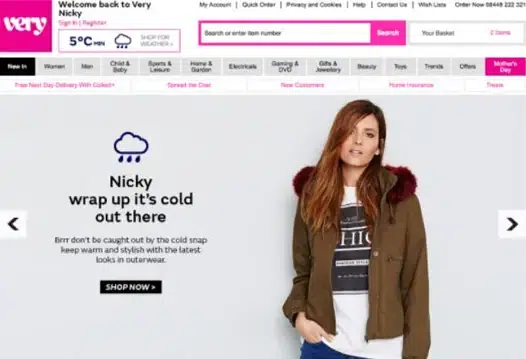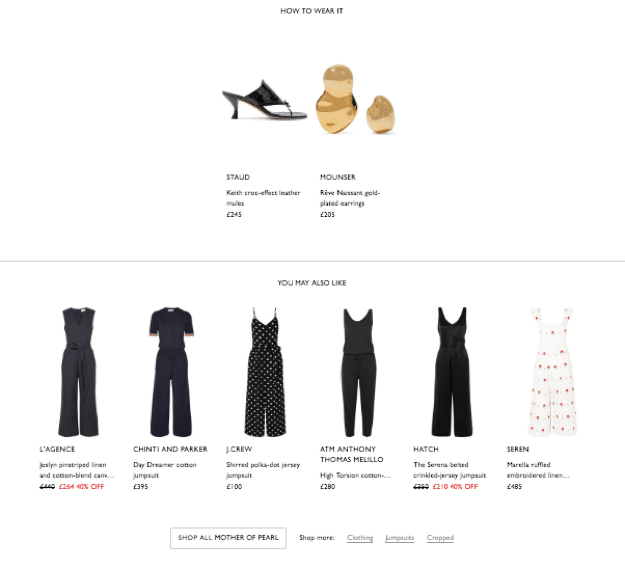A guide to ecommerce personalization
As the customer experience continues to play a key role in standing out, gaining more customers and increasing revenue, ecommerce personalization has much to offer online retailers.
In fact, personalization in marketing has a huge impact on user engagement, conversions, brand loyalty and advocacy – improving the customer experience all round.
So, how can you incorporate personalization within your eCommerce marketing strategies?
In this guide, we discuss what eCommerce personalization is as well as the benefits of the process. You’ll also find out how to make personalization work for your online store and how to use behavioral targeting and dynamic content to enhance your personalized campaigns.
What is eCommerce personalization?
eCommerce personalization is a marketing strategy that targets products to potential customers based on the data that you have collected about their digital presence.
The kind of information that you collect determines the level of personalization you use.
Although personalization within eCommerce marketing has gained significant traction in the last five or six years, it’s not actually a new concept.
In fact, personalization techniques have been traced back to the 1870s, when the first personalized direct marketing letters were sent out to businesses.
Modern personalization, on the other hand, consists of many different layers, such as:
- Location diagnosis
- Tailoring the content of a message
- Segmentation based on user demographics
In effect, ecommerce personalization is the practice of delivering the right message at the right time and in the right place. Examples include a personalized email marketing campaign, product recommendations or location-based offers.
With real-time accessibility of data, ecommerce marketers can use information that directly targets the recipient as a single individual – increasing the likelihood of conversions.
In general, personalized marketing is often seen as the “key to success” in the digital world.
However, you should also keep in mind that personalization can cause controversy.
While there is much evidence to suggest the process is beneficial, the fact that it is based on personal information can create discomfort for some customers.
A recent study has found 69% of Europeans believe businesses may misuse the personal information that they collect – being transparent is key.
In addition to this, GDPR has created a challenge for many online retailers to identify site visitors and gather as much data as possible. With the appropriate content, data can be stored but you must have a clear privacy policy and state how the data will be used.
Any successful ecommerce personalization strategy must add value for the customer.
So, how do you determine what’s valuable?
McKinsey suggests using the following formula:
Value*=[Relevance + Timeliness / Loss of privacy] Trust
*Value to the customer
What are the benefits to personalization?
Drives revenue
From looking at eConsultancy’s Conversion Rate Optimization Report, 93% companies have seen an increase in conversion rates when using personalized marketing strategies.
Moreover, the Salesforce State of Marketing Research shows that 77% of companies that delivered personalization experienced revenue growth the following year. This figure stands at 93% for those who used an advanced personalization strategy.
Improved customer experience.
eCommerce personalization enables retail companies to adapt the customer experience to the specific needs of an individual – listening to their needs, wants, emotions and personalities.
A recent survey by Cloud IQ has found that 64% of respondents expect an individualized experience, while over 80% think such an experience is important.
Customers seek relevant and personalized offers, to be listened to and remembered.
Increased brand loyalty.
A business that dedicates time and resources to implement a successful personalized marketing strategy will benefit from brand loyalty, customer satisfaction and repeat purchasing.
In fact, 44% of customers say that they will likely become repeat shoppers after a positive personalized shopping experience with a company.
On top of this, the same research found 32% of customers that experience personalization will leave a positive online review and 39% will tell friends or family.
How do you make personalization work for your store visitors?
Segmenting your website traffic is often the first step of personalization as the closer you can get to the broad expectations of visitors, the more engaging experience you can create.
Here are six ways you can segment your website traffic:
- New visitors, returning visitors who are customers, returning visitors who are not
- Traffic sources (where the user arrived from, e.g. email campaign)
- Geolocation or IP address – language, currency, country, region, city, weather
- On-site behavior
- UTM parameters
- Device – mobile, tablet or desktop
How do you show dynamic content (web content that changes based on the behavior, actions and interests of the user) to these segments?
For starters, with new visitors, you may show a one-time discount coupon for a customer’s first order in exchange for signing up to your mailing list.
With returning visitor segments, you could display their previous browsing history on your homepage with a section titled something similar to “recently viewed items”.
Traffic sources can reveal a lot about an online shopper – including their intent, interests or industry.
For example, a source coming from Amazon may have a higher purchase intent than those coming from a social media website.
Here, you could offer this segmented group free shipping for one day only to encourage the likelihood of a completed purchase or a one-time discount coupon.
In terms of personalizing based on geolocation or IP address, it might be an idea to personalize your prices dependent on the location of the site visitor, or perhaps make use of weather-based product recommendations.

(Image from Pure360)
When using UTM parameters to segment a group of visitors, you can alternate between referral sources, different campaigns and content types.
Behavioral targeting for personalized marketing.
Segmentation of your site visitors can only take you so far when it comes to personalization.
The next step is to make use of behavioral targeting in order to transition into a one-to-one personalized marketing strategy.
This level of targeting goes beyond traditional demographic targeting and instead attempts to capture those who perform specific on-site actions and patterns, such as:
- Number of previous site visits
- Most frequented category pages
- Guest vs. registered members
- Purchase history
- Referral traffic source
- Geolocation (location, weather, temperature)
- Devices used
Tracking and using this data enables you to create a one-to-one customer experience, which contributes to highly engaged customers and in turn directly impacts your revenue stream.
For example, consider Amazon.
Each person that visits the marketplace sees a completely different version of the homepage. Why? The leading business personalizes each and every one.
Content personalization helps retail companies to increase conversions and drive revenue.
In fact, a recent study from Evergage has found that 98% of eCommerce marketers believe that personalization impacts customer relationships – with nearly 75% suggesting it has a strong or extreme impact on advancing these relationships.
Find out how to use artificial intelligence to enhance your personalization strategies.
On-site personalized marketing:Dynamic content.
Using behavioral data, you can create eCommerce personalization strategies on your website.
One way in which you can accomplish this is through the use of dynamic content blocks.
Dynamic content blocks are specific areas on your webpages dedicated to providing customized content that is specific to groups or segments of site visitors.
For example, if you are a UK-based company you may offer free shipping for orders over £30 in a banner at the top of your website, and for a USA visitor this may change to £100.

Such content blocks include modal pop-ups, banners and image sliders.
Another effective way to drive revenue through personalization techniques is to use dynamic personalized product recommendations.
These personalized product recommendations are based on site visitor data, behavioral data and session history. The main objective is to increase the average order value of each shopping session per customer.
This can be achieved through cross-selling and up-selling strategies.
For instance, a fashion retail site may have a “you may also like” or “how to style” image slider section below the fold on a product page. These are product recommendations tailored to the user’s shopping history and product choice.

Another example of dynamic content is the HTML content of a landing page or an email campaign that adapts itself to display information that is relevant for the customer based on location or previous interactions with your website.
Other common textual elements that could be transformed into dynamic content include:
- Location
- Weather
- Temperature
- System details (browser or device)
- Name
- Gender
- Visited products
- Previous actions on-site
What are the benefits of dynamic content?
On top of the advantages that come with personalization, dynamic content can create a much more user-friendly experience and in turn increase KPIs such as bounce rate, return visits and conversions.
What’s more, once the page is live and active, it doesn’t need to be tended to again.
Off-site personalized marketing:Social media and email campaigns.
In addition to on-site personalized marketing strategies, you can also deliver personalized experiences when customers aren’t on your website.
For instance, social media is likely to be a key channel to communicate with your customers and it is important to create custom audiences to target your existing customer base.
With some social media platforms (e.g. Facebook, Twitter and Pinterest) you can create custom audiences for retargeting website traffic, based on the following insights:
- Website visits
- Product page visits
- On-site searches
- Products added to a shopping cart
- Checkout sessions
- Previous purchases
As you can respond to your customers in real-time, you can personalize each and every response to make them feel heard and listened to. Creating these personalized interactions can increase brand loyalty and brand reputation.
Another popular method to engage in off-site personalization is through email marketing.
Did you know that emails that are personalized are 26% more likely to be opened and marketers have seen a 760% increase in revenue from personalized email campaigns?
Here’s what you can personalize within an email:
- Customer name within email
- Subject line (e.g. use of first name)
- Email copy (e.g. gender, clothing size, birthday)
- Email imagery (e.g. location-based images)
- Dynamic content offers (e.g. showing menswear to male subscribers)
Looking for some email marketing best practices? Recover lost eCommerce sales with this abandoned cart template, examples and tools.
By integrating recent purchases or a customer’s browsing history into your personalized email marketing campaigns, you can create much more relevant and engaging emails that are likely to boost sales through cross-selling and up-selling.
Personalization drives your sales and revenue.
If one thing’s for certain, it’s that personalization marketing helps to fuel business growth.
By showing relevant and engaging content with a personal touch, online retailers can quickly increase their sales and revenue, all while improving the customer experience.